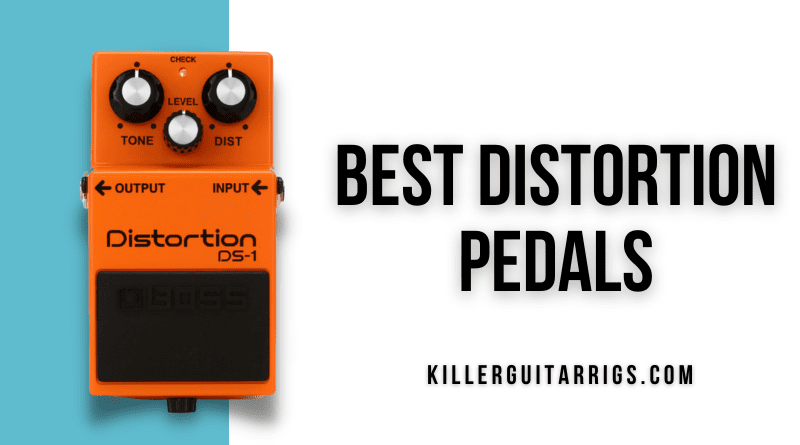For many guitarists, their pedal journey begins by choosing the best distortion pedal for their style of music, and for good reason. This type of sound transformed western music in profound ways and continues to be paramount for all types of musicians.
Naturally, rock is the genre we associate the most with distortion. However, jazz, blues, pop, and even country have been heavily influenced by this unique effect. Today it is not uncommon for some guitarists to have several distortion pedals on their pedalboard, each assigned for a specific function.
There is no doubt that the market is flooded with distortion pedals of all kinds, prices, and different features. These go from your typical types of saturation, from overdrive to distortion, to fuzz, all the way to all-out experimental textures.
In this round up, we’re going to look at the 7 best distortion pedals on the market today. Check it out!
Read more about our review process.
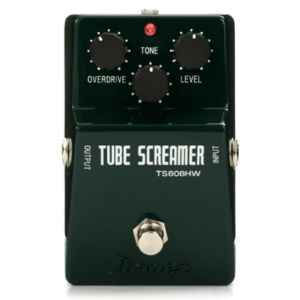
Ibanez TS808HW Handwired Tube Screamer
Features: Hand wired, True bypass switching, Limited Production
Benefits: Genuine vintage TS tones, Peerless build quality, No coloration when off
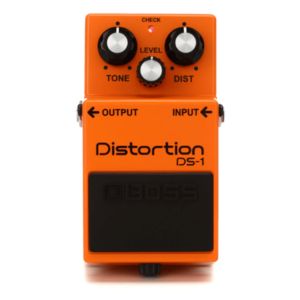
Boss DS-1 Distortion Pedal
Features: All metal construction, Easy operation, Battery/AC Power options
Benefits: Extremely durable, Mild to wild distortion levels, Excellent noise mitigation
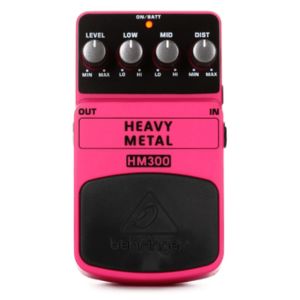
Behringer HM300 Heavy Metal Distortion Pedal
Features: Plastic construction, Level/Low/Mid/Dist controls, Non slip rubber pad
Benefits: Extremely lightweight, Affordable performance, Great range of tonal controls
Contents
Our Top 3
The Boss DS-1 is Our Top Pick for best distortion pedals, as it has been around for over forty years and still offers great tone, ease of use, and durability in a straightforward design. This unit is Boss’s best-selling distortion pedal ever, and for good reason.
The Behringer HM300 Heavy Metal is our Best Budget Option. Despite its name, this pedal can give you everything from overdrive to heavy distortion in a well-built unit that is a good choice for the money.
Finally, the Ibanez TS808HW Hand Wired Tube Screamer is our Editor’s Choice. This legendary pedal is perhaps the most revered distortion effect ever and features great tones and beautiful sustain. This particular version is hand-wired and made with even better components, making it great for discerning players.
Individual Reviews
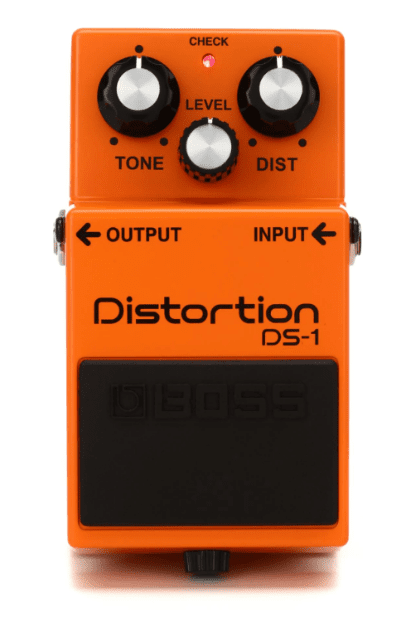
Boss DS-1
A staple of distortion for over 40 years.
This Boss stompbox has been the best-selling distortion pedal for good reason. It has been used by many legends, from Kurt Cobain all the way to Steve Vai, as well as droves of guitar players around the globe. Whether your guitar features single-coil or humbucking pickups, the DS-1 delivers fantastic tone at a great price.
The Boss DS-1 features a simple three-knob design that can give you a number of distorted tonal options. This legendary distortion pedal gives everything from overdrive to fuzz in a rugged enclosure that will last you a long time.
The DS-1 also features a scooped mid range, which is a vital part of its distinct sound that has been a staple in pedalboards for years. This, along with its simple design are two of the features that guitarists gravitate towards.
In our tests, we paired the DS-1 with a Strat and a Fender Deluxe Reverb. We first dialed a warm overdrive with the Dist knob at 9 o’clock, ideal for a variety of situations from pop to a blues solo.
We then went for a more aggressive distortion with the Dist knob at 1 o’clock and the Tone knob at 12 o’clock. In this position, we got a powerful crunch that worked great for classic rock and was also a nice option for solos with nice sustain.
To finalize our tests, we went all out to get a killer fuzz tone. We achieved it by dialing in the Dist knob at 4 o’clock, with the Tone knob at 3 o’clock. Here we got fuzz with a serious punch that can fit a variety of harder styles like metal and its derivates.
In short, a fantastic pedal that has stood the test of time with its simple design, rugged construction, and fantastic tone. This Boss stompbox is a modern classic.
Verdict: The Boss DS-1 is a great option for a variety of guitarists from different styles. It offers simplicity and a great tone. From overdrive to fuzz, this pedal has got your basic distortion needs covered, while also offering simplicity and durability, which makes it our top pick for the best distortion pedal balancing price and features.

Behringer HM300 Heavy Metal
A good option for some aggressive distorted tones.
This pedal is a good option for folks that are looking for some serious distortion that is also affordable. It is well built and offers you the ability to tweak the tone to your liking, via its two EQ knobs.
The Behringer Heavy Metal HM300 distortion pedal features a straightforward design and is specially catered to heavy metal guitarists on a budget. However, this pedal is also capable of giving you nice overdrive and standard distortion via its four knobs.
The Level and Distortion knobs are self-explanatory and help you dial in your loudness and amount of saturation. On the other hand, you have the Low and Mid knobs that control their respective frequency range.
In our tests, we started by dialing in an aggressive heavy metal type distortion, to try out the intended target of this pedal. With the Distortion knob at 3 o’clock, we were able to get a very punchy metal tone that can work in a variety of hard styles.
We then turned the Low tone knob a bit counterclockwise at different levels. Here we got several scooped mid tones that can work well in a modern metal context.
We then tried an overdrive sound by putting the Distortion knob at 8 o’clock with both the Low and Mid knobs at 12 o’clock. We sure liked what we heard, especially with our strat on pickup position 4, for a warm overdriven tone that can work in several contexts and situations.
This pedal is a good option for guitarists that gravitate toward harder styles of music but that occasionally need a softer overdriven tone. If you are on a budget and need a distortion pedal, you may want to check it out.
Verdict: The Behringer Heavy Metal HM300 distortion pedal comes in a 4-knob design that is intuitive and easy to use. This pedal is a good option for those folks that play heavy metal or similar styles and are on a budget. It is well built, easy to use, and gives you good tone for the money, making it our choice for the best distortion pedal for people on a budget.
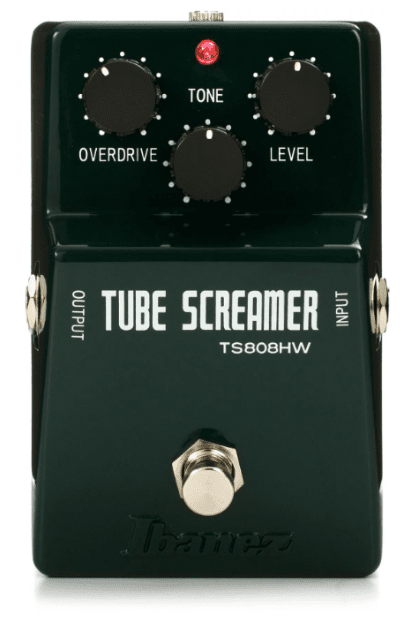
Ibanez TS808HW Handwired Tube Screamer
A limited version of the ultimate distortion pedal.
Known by many guitarists simply as the Tube Screamer, this pedal is arguably the most legendary when it comes to distortion. It is available in different variations and has been a centerpiece of guitar tone for decades.
The Ibanez TS808HW Tube Screamer is a limited edition, hand-wired version of one of the most celebrated distortion pedals in history. Ibanez built this limited production version with fine components and point-to-point soldering, making it the most special in the TS family.
The build quality of the pedal is nothing short of stellar, and while the simple 3-switch design remains, each switch is far better in quality than in other Tube Screamers.
In our tests, this pedal delivered incredible saturation and was even better than other Tube Screamers we have previously worked with. When paired with our Strat going into our Deluxe Reverb, we heard that it was much more open sounding. This is because its design features less overall compression and a circuit design that results in a less severe bass cut.
In true Tube Screamer fashion, we got beautiful warmth when we wanted overdrive, and punchy crunch and gain when we dialed in classic distortion. One of the reasons the Tube Screamer is so respected is the fact that it complements your natural guitar tone, rather than changing it.
It is also easy to use and very musical. With just three knobs, labeled Drive, Tone, and Level, this is an uncomplicated pedal that sounds great in just about any setting.
In short, this hand-wired version of the legendary Tube Screamer is worth every penny, mostly for discerning players that understand and value the tradition and tone that this pedal provides.
Verdict: The Ibanez TS808HW Tube Screamer is a special version of one of the most sought after distortion pedals in history. A staple in guitarists’ pedal boards, the Tube Screamer gives you great tone and ease of use in a simple design and rugged construction, and this particular version uses enhanced components and features on an already spectacular design, making it our editor’s choice for best distortion pedal.
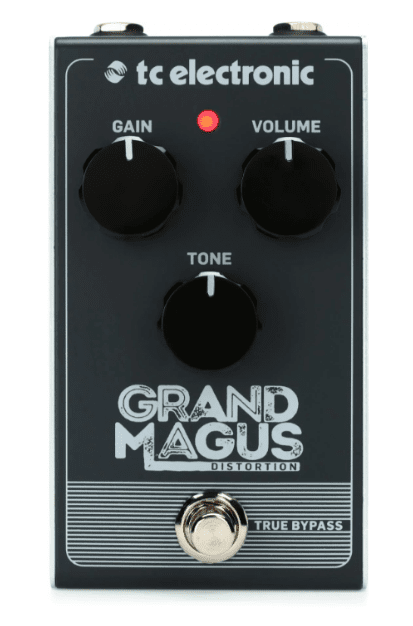
TC Electronic Grand Magus Distortion Pedal
Versatility for different styles for guitarists of all genres.
TC Electronic has been making quality effects pedals for a while, and the Grand Magnus is further proof. This pedal gives you great versatility and it does a great job running the full scope of distortion levels, with great tone and durability to boot.
TC Electronic Grand Magus Distortion Pedal was designed to provide good overdrive, distortion, and fuzz. It features True bypass switching that preserves your tone when not in use and a small 15 mA current draw that will be most welcome on overcrowded pedalboards.
We started our tests by dialing the Gain knob a bit past noon with the Tone knob at 1 o’clock and got a sweet punch and balanced sound that was great to play power chords and riffs in a hard rock context.
We then rolled back the gain to about 9 o’clock and got a very warm overdrive that worked great with open chords, particularly in positions 2 and four of our Strat. The tone here had a bit of a Tube Screamer quality, especially in the mid to high mid frequencies.
When it was time to test out saturation for more aggressive styles, we dialed the Tone knob to 3 o’clock with the Gain to about the same. Here we got some serious growl and powerful sound with great string separation. This setting is great for metal and similar styles, especially if you run it into an amp at breakup point.
This pedal can run with a 9-volt battery or a standard center-negative 9 volt DC power supply, that you have to purchase separately. Although this is a good-sounding distortion pedal, there are other options that may fit a traditional player a bit better.
Verdict: TC Electronic Grand Magus Distortion Pedal offers you traditional overdrive, distortion, and fuzz, all in one well-built pedal. It features true bypass switching and a simple 3-knob design that resembles some of the most popular distortion pedals on the market.

Gamechanger Audio Plasma Pedal High Voltage
A special pedal for adventurous guitarists looking for uniqueness.
A very unique pedal for players that are looking for something off the beaten path. The Gamechanger bucks five decades of traditional distortion pedal design and does justice to its name.
The Gamechanger Audio Plasma Pedal High Voltage distortion pedal offers something truly unique. In essence, it transforms audio signals into a beam of high voltage electricity in a vacuum tube filled with xenon.
The speed and character of this beam generation then transform these incoming signals into an exceptionally percussive and very irregular type of audio distortion that is rich in harmonics.
In other words, unlike most distortion pedals, the Gamechanger does not rely on driven tubes, transistors or clipping diodes to achieve breakup. Instead, it transforms your audio signal into a series of constant high-voltage discharges inside a vacuum tube filled with xenon. Said discharges are then instantly transformed back to an analog signal that’s loaded with harmonics and unique distortion artifacts.
In our tests, we got something unique in every single setting we tried. We started with the bridge pickup in our Strat and dialed in aggressive distortion with both the Blend Knob and Voltage knob at about 2 o ‘clock, while the Low Freq and High Freq knobs remained at noon.
We got a wacky fuzz that was very rich in harmonics and had a uniquely distinctive flavor to it. We then dialed both the Blend and Voltage knobs back to get an overdrive that also sounded nothing like we ever heard before.
Although both were powerful and rich distortion sounds that can be used in different contexts, these tones are particularly good for guitarists looking for something different.
The Gamechanger is a really good pedal, but definitely one for guitarists looking for uniqueness and willing to experiment. Traditional folks might feel out of place with this pedal.
Verdict: The Gamechanger Audio Plasma Pedal High Voltage distortion pedal is a great choice for guitarists that are looking to experiment with something unique. This pedal’s operation is based on high voltage electricity flowing into a xenon-filled vacuum tube, and curbs all conventionality when it comes to distortion.
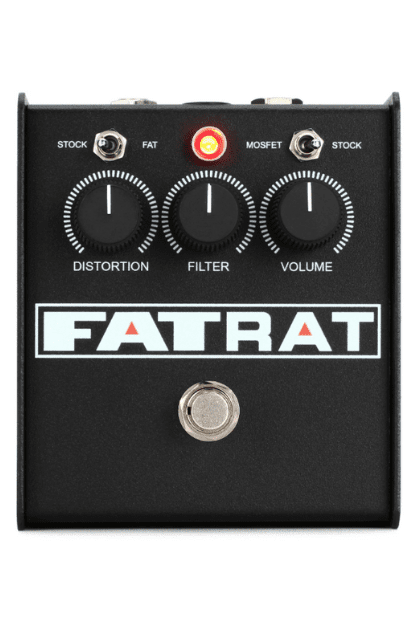
Pro Co Fat Rat
An updated take on a classic pedal with a revered sound.
This pedal offers you the traditional tone of one of the best-known distortion units ever, as well as enhanced options. It is well built and gives you flexibility and a distorted sound filled with character.
The Pro Co Fat Rat builds on the legacy of the Rat, the 70’s pedal known for its sonic flexibility. This takes this versatility further by adding a selectable MOSFET clipping circuit. This circuit offers a smoother upper midrange than a typical RAT, and also adds an amp-like tone.
However, the good parts still remain. Just like the original Rat, this distortion pedal features a silicon clipping circuit that produces that classic harmonic-rich tone that’s been so popular among guitar players (leading to a veritable army of RAT clones).
In our tests, we started by trying out the Fat setting on the top left switch. We got a distortion with a very powerful low end as well as a high cut that sounded treat, particularly when we down-tuned our strat.
This pedal still features that familiar and simple 3-knob layout and comes with solderless op-amp swapping as well as 18-volt operation that gives you increased headroom.
We then tested the right-hand switch on the Mosfet position where we got a very warm and balanced amp-like tone that can work great in a variety of rock and blues contexts.
Moving the switch to the Stock position, we got a tone that was more traditional rat, with that sweet sustain that works so well for solos and single lines.
In short, a nice enhancement to a classic pedal. Here you get a traditional Rat tone with a bit of a nice twist as well as the world-famous Rat sound. Although a nice-sounding pedal that is based on a classic, modern players may want to look elsewhere.
Verdict: The Pro Co Fat Rat is an updated and even more versatile version of the classic pedal. Here you get traditional Rat tones as well as options that enhance the low end and make give you an amp-like tone via its new switch options. This pedal is well built and a great buy for players that gravitate towards traditional distortion tones with a twist.
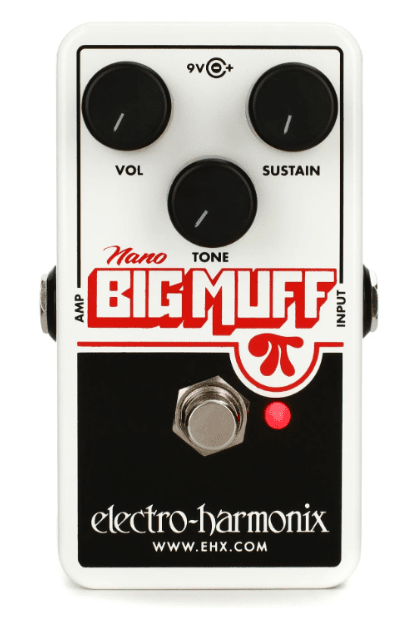
Electro-Harmonix Nano Big Muff Pi
A smaller version of a beloved pedal.
The Big Muff distortion pedals have been around for decades and come in several different models that offer distortion flavors with a clear identity. Guitar players have appreciated the fat tones and even experimental nature of these pedals, and legends like Jimi Hendrix, David Gilmour, and Carlos Santana have used Big Muffs extensively.
The Electro-Harmonix Nano Big Muff Pi is a compact size version of the legendary Big Muff, that can fit easily on just about any pedal board. Just like the original, the Nano is built like a tank and comes in a 3-knob design.
Much like all the Big Muff versions, the Nano gives you a broad range of aggressive tones but remains versatile and usable for a variety of styles. This pedal provides warm and smooth overdrive, great classic distortion and fantastic fuzz that can take you into experimental territory.
In our tests, we began by playing with the control that makes the Big Muff tick: the tone control. This simple knob covers a wide sonic domain that runs the gamut from warm saturation all the way to wacky fuzz.
We started by dialing by placing the tone knob around 10 o’clock with the Sustain knob at the same level. Here we got an aggressive overdrive that can work wonders in any rock context as well as in a blues setting.
To make our sound even bigger, we took the Sustain knob all the way to noon, to get a beautiful tone that is great for lyrical solos that shine with note sustain.
We worked our way up the distortion level with the Tone knob at around 2 o’clock and the Saturation at around 3 o’clock where we got a killer fuzz-like sound that can work for experimenting with textures while moving both knobs slightly around the same area.
In short, a smaller version of the beloved Big Muff that works quite well, but may be an acquired taste for some folks.
Verdict: The Electro-Harmonix Nano Big Muff Pi is a smaller version of the famous Big Muff, featuring the same intuitive design and fantastic build quality. This pedal is a great option for guitarists that like the EHX sound and want to have a Big Muff that can easily fit in their pedalboards.
How To Choose The Right Pedal For You
Analog distortion pedals function in a similar way to preamplifier distortion. However, using vacuum tubes to create distortion is not practical. This is because most distortion pedals function using battery voltages.
Therefore their design features solid-state transistors, op-amps, and diodes. The rest is similar. Distortion happens when gain is added to an audio signal, pushing it past its peak.
Technical concerns aside, the first thing to consider is what you need the distortion pedal for. Asking yourself some important questions will take you there.
Do you need a pedal to play 80’s rock covers as well as other classic rock gigs? Are you a jazz player that wants to venture into fusion or seek a tone similar to John Scofield’s? Are you a pop singer-songwriter that occasionally needs a boost and/or overdrive for some songs?
As simple as they sound, these questions will reveal a lot about what you need. There is also the possibility that you need to cover all the areas described above. In that case, you need to get a versatile pedal that fits your needs.
There are many types of distortions, but we listed the most common and useful below.
Overdrive
Overdrive is often described as the mildest type of distortion. It works great in a number of scenarios and genres, from pop to soft rock and blues. Whether you need to add some power to open chords or have your single lines sing and stand out a bit more, overdrive is a top choice.
With overdrive, you get more sensitive dynamics, and a good overdrive pedal will respond to your playing. There are great overdrive pedals out there, and some offer this particular flavor along with more aggressive distortion.
Distortion
Simply referred to as distortion, this is perhaps the most sought-after of all flavors of this effect. It adds a consistent crunch to what you’re doing as opposed to taking your original tone and pushing it harder like an overdrive.
Distortion is the cornerstone of classic rock and much of the blues and jazz scene from the 70s and 80s. It is still used today and remains a top effect for most guitarists.
As a matter of fact, it is hard to think of an electric guitar player that does not have at least one good distortion pedal on its rig. Naturally, if you play anything that is rock or relatively close, chances are you are going to need a good distortion pedal.
Fuzz
Fuzz can be thought of as the most aggressive type of compressed distortion. It severely alters the waveform and turns into a square wave that may sound like the world is ending.
Although this type of distortion is also popular, is not as widespread as the other two we mentioned above. Some may think that fuzz is typically used in more aggressive types of music and experimental contexts.
Although that is true, the fact is that many guitarists who don’t play aggressive music use fuzz tastefully for specific purposes. For instance, Keith Richards of the Rolling Stones has created iconic lines using fuzz pedals.
In other words, fuzz is a type of distortion that can be used in endless contexts. Unfortunately, it commonly gets lumped with the experimental and darker music genres.
Common Questions & FAQ
Final Thoughts
Distortion is the most enduring guitar effect ever. Truth be told, it is also used by other musicians and producers in an extensive number of settings and contexts.
Simply said, music as we know it would be totally different without distortion. It is hard to think of another effect that has had such a deep impact on how songs are written, recorded, and consumed.
To recap our choices, the Boss DS-1 -is Our Top Pick, with its great tone and a simple design that has made it Boss’s best-selling pedal ever.
The Behringer HM300 Heavy Metal is our Best Budget Option and will have you covered whether you need overdrive or heavy distortion on an affordable unit.
Finally, the Ibanez TS808HW Handwired Tube Screamer is our Editor’s Choice, featuring a hand-wired construction and made with better components, with the killer tone that has defined generations.

